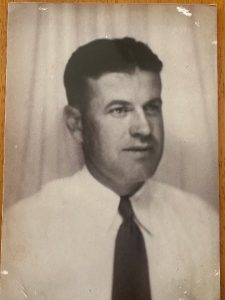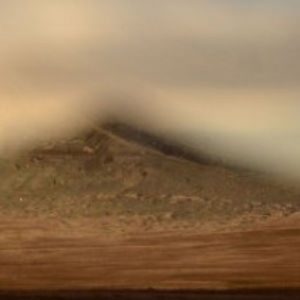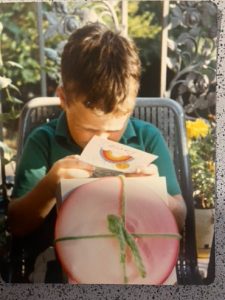[Read live as part of “Risking a Memoir”, with Ervin Malakaj, May 10, 2024.]
- Puny Pink
 When three excited medical students diagnosed my brother’s albinism at St. Mary’s in Madison, Wisconsin, my father (also a medical student) disappeared into a nearby washroom and threw up. There would be, in the coming weeks, suggestions that they keep my brother in a dark room for most of his childhood, that he wear sunglasses all the time, even that he wear dark contact lenses with a pinhole in the middle to stimulate the production of retinal rods and cones. But the person who, my mother said, eventually gave my parents the best advice was a Dr. Opitz, a geneticist who himself had Marfan syndrome, and he took my brother into one of his gigantic hands and told my mother: Take this baby home and love him. She saw this doctor just once, but I think no other stranger’s intuitive de-escalation of things benefited me more than his did in that one moment, eight years before I was born.
When three excited medical students diagnosed my brother’s albinism at St. Mary’s in Madison, Wisconsin, my father (also a medical student) disappeared into a nearby washroom and threw up. There would be, in the coming weeks, suggestions that they keep my brother in a dark room for most of his childhood, that he wear sunglasses all the time, even that he wear dark contact lenses with a pinhole in the middle to stimulate the production of retinal rods and cones. But the person who, my mother said, eventually gave my parents the best advice was a Dr. Opitz, a geneticist who himself had Marfan syndrome, and he took my brother into one of his gigantic hands and told my mother: Take this baby home and love him. She saw this doctor just once, but I think no other stranger’s intuitive de-escalation of things benefited me more than his did in that one moment, eight years before I was born.
And so, this is essentially what my mother did. But she also tested my brother more than she tested me. With him, she set up objects and symbols (letters, numbers, colours) for him to try to see at increasing distances, in an attempt to extend his capacity as much as possible. The people from the Massachusetts Commission for the Blind told her not to start using large-print materials, because that would train him and his eyes to expect those kinds of accommodations. With me, my mother did not test or attempt to extend my vision at all, comfortable as she was with my brother’s general success at things.
I do not remember a single person in my life asking me to try to see farther. I do think that the 50,000 or so people I’ve interacted with so far in my life do overwhelmingly think I can see much more than I can, and are baffled when I cannot. But none of those people has asked me to try harder. So the concept and experience of hypopia at the heart of this reflection—of seeing less than you should—is not about how the world has tested me; it is about how that world has not tested me, how it has not gone that far, stopping rather at the bafflement or confusion. I am supposed to see much more than I do: and this is the predicament. It is not a factual state of affairs, like myopia, but an axiological one: the world is generally expecting more of my visual acknowledgement than it can get, and this is an interactional bedevilment, not just for me but for those who try to spend time with me in that world.
In 1969, my grumpa got on the phone with my mother—gramma had handed the receiver to him—and he said he thought she should know that my newborn brother’s eye problem might have something to do with his own “puny pink” eyes. At least you won’t have to put him in an institution, Kath, he said. Grumpa had failed out of school in eighth grade—apparently for cheating, but really because he couldn’t see the blackboard to save his life. People expected that he could see more than he could, and it was unnerving to the nuns who thought he must be cheating or inattentive. As an adult, he turned down good jobs (landscaping the Tedeschi’s convenience stores across the South Shore) because there would just be too much driving. As kids, my mom and her girlfriend Maryanne would wait in Rockland, Massachusetts, for him to drive very slowly down Reid Street at the end of the workday, waving at him, knowing he would not see them as he drove by. There goes your father, said Maryanne to my mother every day.
* *
- Exacting
 Do you think this photograph is beautiful? Do you think this photograph is as beautiful as I do? Look at the wheatpaste, or whatever that is at the base of the glass? These are the colours of the desert: grime, dust, haze. This is the clearest view I have from my window of Black Hill, also called Sentinel Peak, also called A Mountain in Tucson, Arizona. If you google it, you get a lot of angles and views, but this is mine. Tucson is so named because the Tohono O’odham Indigenous people settled at the base of the Black Hill, i.e., Cuk Ṣon 4000 years ago. I am happy that this one photo edits out the ridiculous and massive basalt rock “A” that settler students branded onto the top of Black Hill in the 1910s; that mammoth “A” for Arizona is just one of the thousands of things I do not see every day that I should. Absent such colonial features, this photograph warms me; it is my realism, it is my precision. Yet, because I know it is the kind of photograph that looks like a mistake, a false click, a butt dial, I am usually inclined to delete them.
Do you think this photograph is beautiful? Do you think this photograph is as beautiful as I do? Look at the wheatpaste, or whatever that is at the base of the glass? These are the colours of the desert: grime, dust, haze. This is the clearest view I have from my window of Black Hill, also called Sentinel Peak, also called A Mountain in Tucson, Arizona. If you google it, you get a lot of angles and views, but this is mine. Tucson is so named because the Tohono O’odham Indigenous people settled at the base of the Black Hill, i.e., Cuk Ṣon 4000 years ago. I am happy that this one photo edits out the ridiculous and massive basalt rock “A” that settler students branded onto the top of Black Hill in the 1910s; that mammoth “A” for Arizona is just one of the thousands of things I do not see every day that I should. Absent such colonial features, this photograph warms me; it is my realism, it is my precision. Yet, because I know it is the kind of photograph that looks like a mistake, a false click, a butt dial, I am usually inclined to delete them.
Christina Sharpe writes in Ordinary Notes that kinship is the ghost in the machine of racism, and she wants white supremacist heritage photos, photos of desirous white lynchers, to be enlarged in the museum collections where they are displayed. I am almost always in favour of things being enlarged, regardless of the purpose. I meander through museums with the people who bring me along with them, and am usually bored by the hundreds of interesting things I cannot see. By the time I get to something I can see, I’ve usually fallen into a soporific despondency and can’t be bothered to struggle against it. I wonder what a museum would look like that enlarges absolutely everything, where the essence of all of it were visually present and therefore enchanting.
This photo of A Mountain—which I took and considered immediately discarding, and which no one else I can imagine would have taken with any sort of eventual affection—is the closest I can get to an essential and realist engagement with the thing itself: with its haunted, simply colossal persistence. How I love the three, four, five superimpositions: the window pain below, then one thick and grimy layer at the base, then one gently and spiderly descending sweep from the upper left, the mountain itself being dark and simple, and the sky. I’ve heard that pedagogies of Disability call this kind of thing scaffolding: these five layers bring me closer to the essence of the object of viewing, the closely faraway mountain, which to some is a sacred hill, which to others is a settler’s brand. I need these layers, each of which is a highway into an expanse of relations. They are not obstructions, or if they are obstructions, they are the lovely ones, the incitements to climb, to not discard, to not turn away in what is not, but what may look like, painful shyness.
* *
- Pocket Squares
 I titled this book Aloof because aloofness has been kind of scuttling along the dark floor of my life since before I could spell my own name, a nightmare-of-the-self I never until very recently knew how hard I’d been trying to outrun. Aloofness is something that I have, but don’t have the means to own, like an inscrutible entail from a disliked relative. One of my professors in grad school, a jolly gay mandarin with a weekly regime of pocket squares, worried aloud to me once that We wouldn’t want anyone to think you’re aloof.
I titled this book Aloof because aloofness has been kind of scuttling along the dark floor of my life since before I could spell my own name, a nightmare-of-the-self I never until very recently knew how hard I’d been trying to outrun. Aloofness is something that I have, but don’t have the means to own, like an inscrutible entail from a disliked relative. One of my professors in grad school, a jolly gay mandarin with a weekly regime of pocket squares, worried aloud to me once that We wouldn’t want anyone to think you’re aloof.
Berkeley’s Dwinelle Hall has these long corridors, and it was for sure a daily event there that I would totally ignore some powerful person’s subtle greeting who held the keys to my professional success. This likely happened whenever one of them entered that long corridor at a distance of 40 feet, which is just about 30 feet too far for me to even try to see anything. This one professor with the pocket squares bore an earnest concern about this, and felt it reasonable to bring it to my aloof attention. Care for the younger generation’s professional future welfare, and particularly about how their aesthetic habits might affect that welfare, often opens up in academic authority figures a whole battery of anticipatory fears, the expression of which is urgent, indirect, and frequently offensive. It allegedly wasn’t that he thought me aloof, so much as that he feared the likelihood that others might do so. One might think; man möchte denken.
I’m honestly not sure now 20 years later whether this professor had expressed his worry to me in German or English, but something about the word “aloof” sticks with me in memory from that day. Aloof. How related is aloof to other impeachable words like saloon and spittoon—words that bear a whole history of moral compromise, fallenness, and gaucherie with them. Finding oneself next to a spittoon in a saloon—probably in Burbank or Toledo or Marseille—never bodes well for one’s character, credibility, strategic foresight, or professional prospects. Let’s go ahead and say this professor had been speaking English to me, especially since I now cannot for the life of me imagine what German word he would have used instead of aloof. Hochnäsig, perhaps?
Surely, it would have been quite a different thing for him to say, “we wouldn’t want anyone to think you’re aloft.” Aloftness is a more uncompromised circumstance than its clownish little cousin, aloof. Aloftness has heft, it is contundent. Something aloft has weight that pounds in the air. Heft and aloftness, I feel, are relational. Their combined weightedness and airiness derive from the torque of endurant interaction that bring credibility to them. Not having heft means not having relations, a peoplelessness.
Across the nation, there’s been unveiled a newish string of hotels called Aloft Hotels. I’ve stayed in these hotels, reserved rooms in them for friends, rolled the name around in my mouth with accommodating enthusiasm. Marketing since the 1990s has figured out how to saturate us not with the utility of the product itself, but with the utmost feeling the product promises to provide. We’ll buy this aloftness for $299 a night, even at the corner of Campbell Avenue in Speedway in Tucson, Arizona. Imagine though a competitor, called the Aloof Hotel. What would be the amenities, how would the lobby look? If you had to, at which intersection would you put such a thing? Or at no intersection? Would there perhaps be no access to it, nor egress, at all?
I am wondering about aloofness, because it is so basically unlikeable a trait. Even in those instances when it strives to count as a virtue, it most be apologized for as a procedural infelicity in pursuit of some other, more elusively great, good. I am wondering about aloofness, because I am myself aloof, and it is a terrible and involuntarily thing to be obliged with. This book is about the hundreds of thousands of waking moments where I have bent over backwards trying to prove I am not aloof, and about what this particular scorecard of precautionary insistence written in this body has done to this tongue, to these vertebrae, to my memory, to my dance card, and to my bank account.
I do hope that, once this book is over, you might not begrudge aloofness, but love it curiously in others and in yourself. This is my prayer. I go up the modest eight floors of the Tucson Aloft Hotel and look out to the north at a vague clump of land I think may be the Santa Catalina Mountains. What most people do up here is something I call television, the German for which is Fernsehen, “seeing far”. What do you see far, I ask them? For me, seeing far is called prayer. I pray to anything, unbearably out there, that I can almost see. You’ll perhaps notice from time to time, on the street or down a long corridor, that I am praying to you, too.